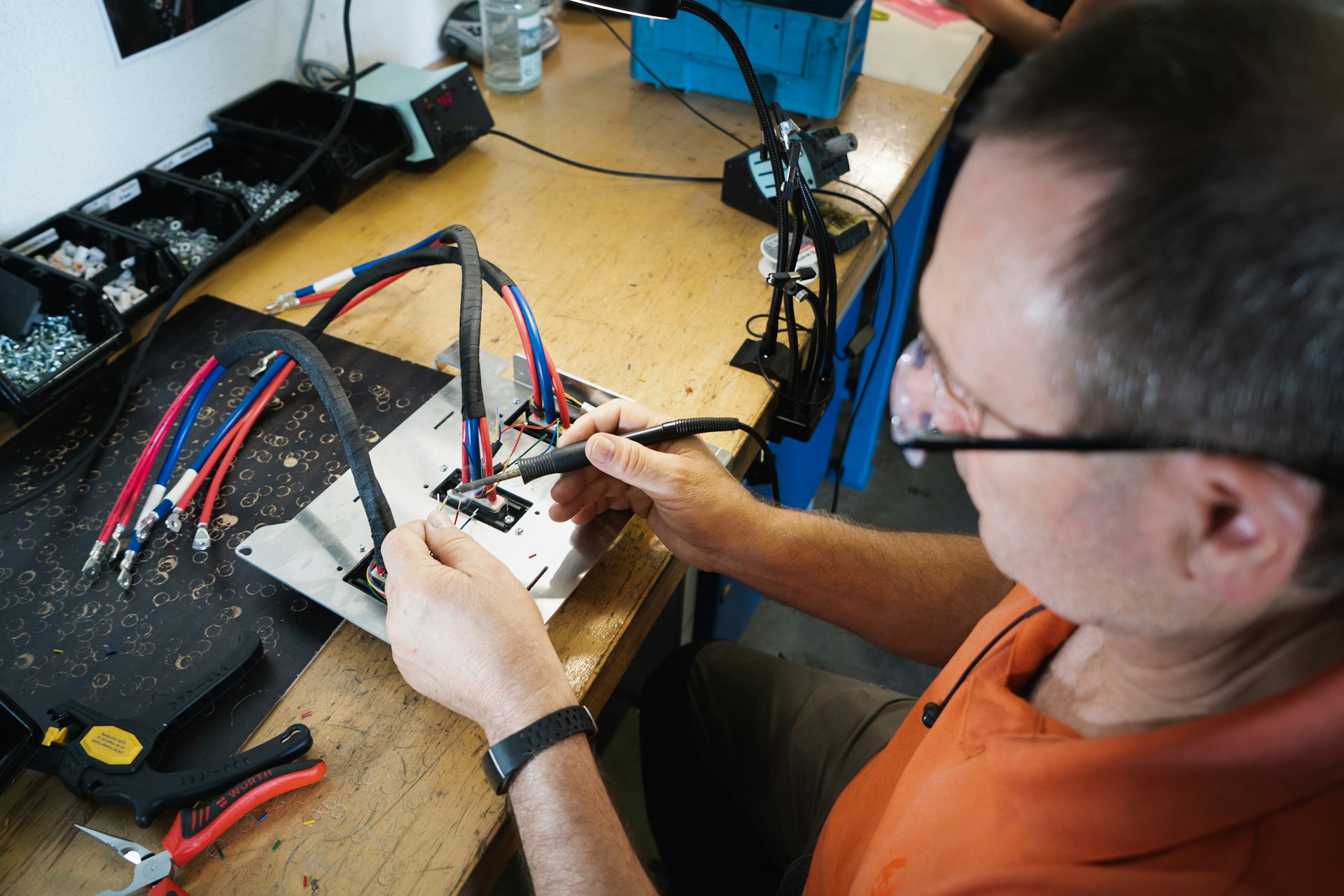When your washing machine starts making strange noises or your refrigerator stops cooling properly, you face a critical decision.
Should you roll up your sleeves and attempt a repair yourself, or is it time to contact an appliance repair technician? This choice can mean the difference between a quick, cost-effective fix and an expensive disaster that leaves you shopping for a new appliance.
Understanding when to tackle repairs independently and when professional service becomes essential protects both your appliances and your wallet. The wrong decision could transform a minor issue into a major expense, while the right choice saves time, money, and stress.
This comprehensive guide examines six crucial factors that determine whether your appliance problem calls for DIY fixes or professional intervention. By the end, you’ll have the knowledge needed to make informed decisions about appliance maintenance and repairs.
Safety Considerations Come First
Electrical Hazards Assessment
Electrical appliances pose serious risks when handled improperly. Any repair involving exposed wiring, electrical panels, or high-voltage components requires professional expertise.
Water and electricity create particularly dangerous combinations, making dishwasher and washing machine electrical issues off-limits for amateur repairs.
Modern appliances contain complex electrical systems that can deliver fatal shocks even when unplugged.
Capacitors in air conditioners and refrigerators store electrical charges long after disconnection, creating hidden dangers for inexperienced repair attempts.
Gas Appliance Dangers
Gas appliances present unique safety challenges that demand professional attention. Improper gas line connections can cause:
- Carbon monoxide leaks
- Gas explosions
- Fire hazards
- Asphyxiation risks
Never attempt repairs on gas stoves, dryers, water heaters, or furnaces without proper certification and equipment. The potential consequences far outweigh any cost savings from DIY attempts.
When DIY Safety Makes Sense
Simple maintenance tasks and minor repairs often fall within safe DIY territory:
- Cleaning lint from dryer vents
- Replacing water filters
- Unclogging dishwasher drains
- Adjusting refrigerator temperature settings
- Cleaning condenser coils
Complexity of the Problem
Simple Fixes You Can Handle
Certain appliance issues respond well to basic troubleshooting and simple repairs. These typically involve:
- Cleaning and maintenance: Removing debris, replacing filters, and cleaning components
- Basic adjustments: Leveling appliances, adjusting door seals, calibrating settings
- Minor part replacements: Changing light bulbs, replacing worn gaskets, and installing new hoses
Most manufacturer manuals include troubleshooting guides for common problems, making these repairs accessible to average homeowners.
Complex Repairs Requiring Expertise
Sophisticated appliance problems demand specialized knowledge and tools. Professional service becomes necessary when repairs involve:
- Internal motor repairs or replacements
- Circuit board diagnostics and replacement
- Refrigerant system repairs in cooling appliances
- Transmission repairs in washing machines
- Control system programming and calibration
These repairs require diagnostic equipment, specialized parts, and technical expertise that most homeowners lack.
Cost Analysis and Budget Impact
Initial Investment Comparison
DIY repairs often appear more affordable initially, but hidden costs can quickly accumulate:
DIY Costs:
- Diagnostic tools and equipment
- Replacement parts (often more expensive for consumers)
- Potential mistakes requiring additional parts
- Time investment and opportunity costs
Professional Service Costs:
- Service call fees
- Labor charges
- Parts at wholesale or discounted rates
- Warranty on work performed
Long-term Financial Implications
Professional repairs often provide better long-term value despite higher upfront costs. Certified technicians access wholesale parts, provide warranties, and prevent common mistakes that lead to additional problems.
Botched DIY repairs can void manufacturer warranties, leaving you responsible for all future repair costs.
This website and similar resources emphasize that improper repairs often cost more than professional service when factoring in potential damage and warranty implications.
Time Investment and Scheduling
DIY Time Requirements
Home appliance repairs consume significant time, often requiring:
- Research phase: 2-4 hours studying the problem and solutions
- Parts acquisition: Half to full day shopping for the correct components
- Actual repair work: Variable based on complexity and experience
- Cleanup and testing: Additional time ensuring proper function
Inexperience typically doubles or triples repair time estimates, making weekend projects stretch into week-long endeavors.
Professional Service Efficiency
Experienced appliance repair technicians complete most repairs within 1-2 hours. Their efficiency stems from:
- Immediate problem diagnosis
- Proper tools and equipment on hand
- Access to correct parts through supplier networks
- Years of experience with similar problems
This efficiency minimizes appliance downtime and reduces household disruption.
Required Tools and Equipment
Essential DIY Tool Investment
Basic appliance repairs require specific tools that many homeowners lack:
Basic Tool Requirements:
- Multimeter for electrical testing
- Appliance-specific wrenches and screwdrivers
- Refrigerant manifold gauges (for cooling systems)
- Specialized pullers and installation tools
Advanced Equipment Needs:
- Oscilloscope for electronic diagnostics
- Vacuum pumps for refrigerant systems
- Torque wrenches for precise assembly
- Safety equipment and protective gear
The tool investment for comprehensive appliance repair often exceeds the cost of professional service calls.
Professional Equipment Advantages
Certified technicians invest thousands of dollars in diagnostic and repair equipment. This professional-grade equipment provides:
- Accurate problem identification
- Precise repair execution
- Safety features protecting both the technician and the appliance
- Specialized tools for specific manufacturer requirements
Warranty and Insurance Implications
Manufacturer Warranty Protection
Most appliance warranties include specific clauses about unauthorized repairs. DIY attempts can void warranty coverage, even if the repair succeeds initially. This loss of protection means:
- Future problems become your financial responsibility
- Manufacturer support disappears for warranty-covered issues
- Resale value decreases due to warranty voidance
Always check warranty terms before attempting any repairs on newer appliances.
Insurance Coverage Considerations
Homeowner’s insurance policies may not cover damage resulting from amateur repair attempts. Professional service provides:
- Licensed and insured technicians
- Liability coverage for accidental damage
- Bonded service protecting against theft or property damage
- Documentation for insurance claims, if needed
Extended Warranty Benefits
Many professional repair services offer extended warranties on their work, providing additional protection beyond manufacturer coverage. These warranties typically cover:
- Parts and labor for repair-related issues
- Service guarantees ensuring proper function
- Priority scheduling for warranty-covered problems
Making the Final Decision
Decision Matrix Framework
Create a systematic approach to repair decisions using these criteria:
Choose DIY When:
- Safety risks are minimal or absent
- Problem appears simple with clear solutions
- Required tools are available or inexpensive
- Time investment is reasonable
- Warranty implications are acceptable
Choose Professional Service When:
- Safety concerns exist (electrical, gas, or structural)
- The problem complexity exceeds your expertise
- Tool investment approaches service call costs
- Time constraints make DIY impractical
- Warranty protection is important
Red Flag Situations
Certain scenarios automatically indicate professional service needs:
- Strange smells (gas, burning, chemical odors)
- Unusual noises suggesting internal component failure
- Electrical problems with sparking or tripping breakers
- Water leaks in unexpected locations
- Complete appliance failure with no obvious cause
Building Long-term Relationships
Establishing relationships with qualified appliance repair technicians provides ongoing benefits:
- Priority scheduling for emergency repairs
- Honest assessments about repair versus replacement decisions
- Maintenance recommendations preventing future problems
- Access to professional advice for appliance purchases
Your Next Steps for Appliance Success
Smart appliance ownership requires knowing when to tackle repairs yourself and when professional service becomes essential.
The decision framework outlined here helps protect your safety, preserve your appliances, and manage repair costs effectively.
Start by assessing your current appliance situation using the criteria discussed. Create a list of qualified appliance repair technicians in your area before problems arise.
Research your appliances’ warranty terms and understand what actions might void coverage. Remember that the most expensive repair is often the one that could have been prevented through proper maintenance.
Whether you choose DIY fixes or professional service, regular maintenance and prompt attention to problems extend appliance life and minimize major repair needs.
The key lies not in choosing one approach over another, but in making informed decisions based on specific circumstances. With this knowledge, you’re equipped to handle appliance issues confidently and cost-effectively.



Leave a Comment